
Being a paddler in the driest inhabited continent means you have to be very committed to your sport. Paddling in Victoria is unreliable at the best of times, but this paddling season proved to be one of the worst the state had ever seen. We had one of the driest winters on record and the driest June in 148 years. Not a single one of the creeks ran, even for a day. The King river, our closest play run and usually a sure bet, never came anywhere near the minimum level. (The dam, which needs to overflow for it to run, is only 70% full.) Of all the advanced runs in a 400km radius only one river, the Mitchell, ran at a slightly above minimum level for about three or four days. Except for that, nothing.
We were starting to lose hope when we heard that, given the unusual drought, the local water authorities would start transferring water from Lake Dartmouth to Lake Hume for irrigation purposes, and keep transferring it down the lower Mitta Mitta until significant rainfall occurred. It started to look like rain or no rain, we would finally get the chance to do some paddling other than in the surf.
Last weekend, six of us decided to make the trip to the lower section of the Mitta Mitta river. Shortly after it comes out of Lake Dartmouth, the lower Mitta flows over a low weir, which forms a nice wave at higher flows. Lucky for us, the water was flowing at a healthy 115m3/s, which meant the wave was pumping. Any higher and the downstream farms would start to get flooded.
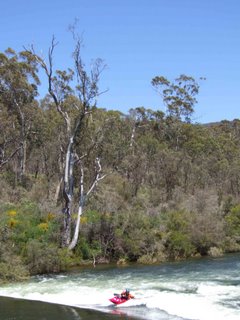
So we met at Jed’s place one Friday after work, loaded up the boats and hit the road. Located in the North-East corner of Victoria, the Mitta is a solid 5-hour drive from Melbourne and by the time we got there, it was nearing midnight. Tim was already there with his girlfriend Courtney while Marty and Dave would drive up the next day.We wasted no time setting up camp and going to sleep. As he assumed we’d stay in a motel and thus didn’t bother bringing a tent, Jed had to sleep in the back of the car (being a Mitta virgin, he didn’t realize how small the Mitta township is). The next morning, we woke up to bluebird skies. Looked like it could be a good day paddling some great water in the high country!
From the car park, we walked down to have a quick look at the wave, which was looking good: fast and green in the center with nice shoulders on either side, a hole on surfer’s left and plenty of depth.

Checking out the wave
Back at the car we got into our paddling gear, relishing the fact that, for once, it was warm enough to paddle with just a drytop and a thermal top. Needless to say this was most welcome in a region where it's not unusual to find your paddling gear frozen solid in the morning. (Yep, Australia can be cold!)
Even though it was only mid-morning, the sun was already beating down on us. We shouldered our boats and made our way through the Eucalypts and Ti-Trees, rays of light piercing through the fragrant trees.

After a quick warm-up we hit the wave. First a few surfs to get a feel for it, then some more aggressive carving, leading to blunts and backstabs, flatspins, cartwheels, etc...
Matt and Dan, two paddlers from Eildon, showed up around noon. They played for a few hours before heading back to Eildon that same day. 8 hours of driving for a few surfs, talk about commitment!
Tired from a long day of playing, we retired back to camp, where we chilled on the grass, swapped paddling stories and listened to the river flow by. For dinner we walked across the paddocks to the local pub. As with all small-town hotels, it was full of colourful characters. Like a dad threatening his 5-year old kid with a bellowing: “Come here! Or I’ll shove my foot up your ass!!!” To which the bartender replied “Yeah, and you won’t have to go to Catholic school to get it, either!”

Tim and Marty carving it up
Our second day was much the same as the first, sharing the wave with Marty and Dave. Every once in a while someone would call a party wave and we even managed to fit all six boats on the feature.

Party wave!
At the end of the day we floated downstream to run Shark’s Tooth. Named after the jagged rocks that lurk just beneath the surface, Shark’s Tooth is a straightforward, grade III rapid with a big volume feel to it. In a playboat, it is quite fun. Don ran it first and straight through the massive hole at the bottom of it, throwing a wicked wavewheel off the top. Having never paddled anything of the kind, Jed followed Marty and made it down safely, putting in a few rolls for good measure. Dave cruised it and I, seeing that the bottom hole wasn’t as nasty as it looked, paddled hard through it, launched off the top and got fully airborne.

Nice cartwheel by Tim
That night, another hearty pub meal saw us drinking beer and playing pool under a vanilla sky, the lavender clouds drifting slowly over the horizon.
Our last day was much like the first two: gorgeous weather, beautiful scenery and lots of crystal-clear water. We were really starting to get a feel for the wave but our muscles were very sore by now and our moves weren’t as snappy as they were at the start of the trip. Marty and Dave tried hard to get us to stay another day but commitments back in Melbourne meant we couldn't give into temptation. We packed up the car one last time (three boats and three people, all inside a wagon), turned it around and headed back towards Melbourne. What a shame to be leaving such a beautiful place...
Mitta line-up

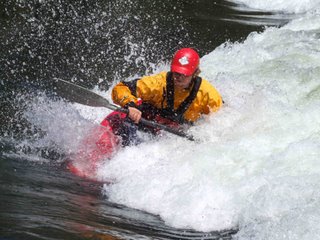

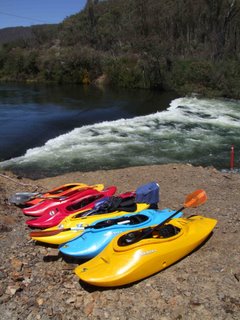



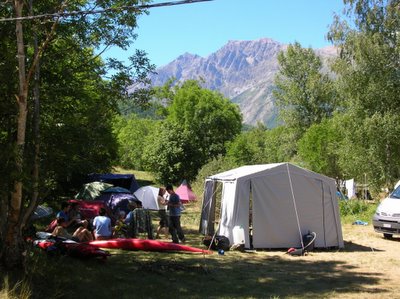
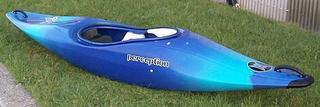
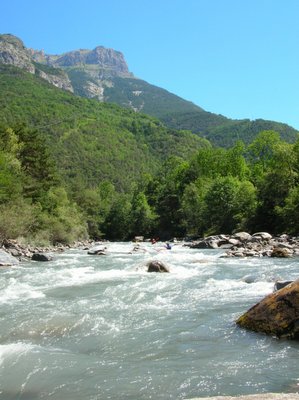

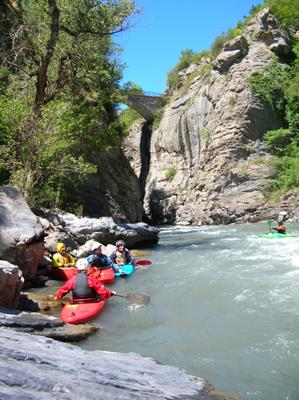







 The siamese brothers: Loïc and Lucien
The siamese brothers: Loïc and Lucien


 After running the top drop without too much trouble, we got to the island rapids, which are described as “challenging class four with many prolonged, steep and creeky rapids. The most difficult part is the series of steep rocky rapids around the right hand side of the island. Although difficult this section is now regularly paddled by highly experienced paddlers.” Well, I’m afraid that was right. The first 4-metre drop looked like instant death and the rest of “The Island” wouldn’t look entirely out of place in an extreme paddling video, either. Now, the good thing about the drop is that it gives the choice of how you’re gonna get hurt. Boof off the tongue in the center and you’ll smash (with your boat if you’re lucky, with your face if you're not) into a huge boulder before getting worked and hit another rock downstream. Stick to the right and you’ll hit the wall before getting mercilessly pounded by 900 cubic feet (that’s about thirty tons!) of water per second. Tough call, isn’it? What about the left line, I hear you say? Well, let’s just say it looks even worse…I looked at a few people running it, some of them even carrying back up to run it again! I asked Rige, who looked like he was thinking about it. “You’re not seriously thinking about running it…are you?” To which he replied that he might actually give it a go. So I started portaging and waited for him downstream and to my great surprise and relief he made it no worries!
After running the top drop without too much trouble, we got to the island rapids, which are described as “challenging class four with many prolonged, steep and creeky rapids. The most difficult part is the series of steep rocky rapids around the right hand side of the island. Although difficult this section is now regularly paddled by highly experienced paddlers.” Well, I’m afraid that was right. The first 4-metre drop looked like instant death and the rest of “The Island” wouldn’t look entirely out of place in an extreme paddling video, either. Now, the good thing about the drop is that it gives the choice of how you’re gonna get hurt. Boof off the tongue in the center and you’ll smash (with your boat if you’re lucky, with your face if you're not) into a huge boulder before getting worked and hit another rock downstream. Stick to the right and you’ll hit the wall before getting mercilessly pounded by 900 cubic feet (that’s about thirty tons!) of water per second. Tough call, isn’it? What about the left line, I hear you say? Well, let’s just say it looks even worse…I looked at a few people running it, some of them even carrying back up to run it again! I asked Rige, who looked like he was thinking about it. “You’re not seriously thinking about running it…are you?” To which he replied that he might actually give it a go. So I started portaging and waited for him downstream and to my great surprise and relief he made it no worries! Rigel at the bottom of the drop
Rigel at the bottom of the drop


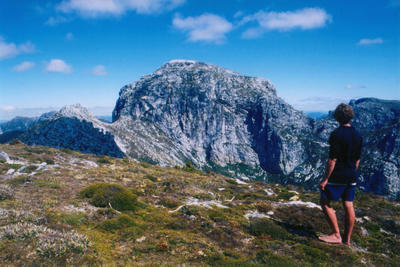

 Eagle's Nest Camp, Great Ravine
Eagle's Nest Camp, Great Ravine Ol' Three Tiers at high flow (Rigel in the center)
Ol' Three Tiers at high flow (Rigel in the center) 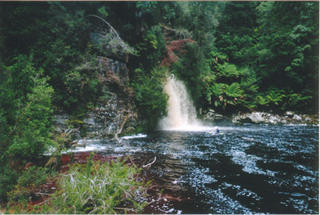 Sir John Falls
Sir John Falls